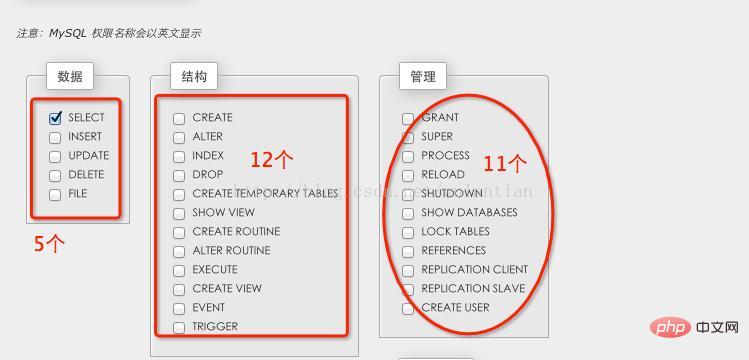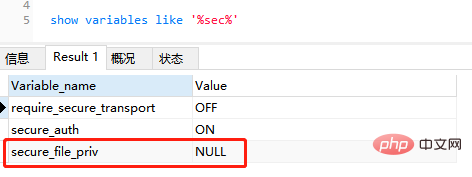What permissions does mysql have?
mysql permissions include: 1. USAGE, which can only be used for database login and cannot perform any operations; 2. SELECT, which allows the use of SELECT statements to view table contents; 3. super, which allows the execution of a series of database management Command; 4. process, allowing to view process information; 5. Shutdown, etc.

The operating environment of this tutorial: windows7 system, mysql8 version, Dell G3 computer.
mysql various permissions:

1, USAGE: connection (login) permissions , when you create a user, the usage permission will be automatically granted (granted by default).
This permission can only be used for database login and cannot perform any operations, and this permission cannot be recycled. Even if REVOKE is used, the user permission cannot be deleted.
grant usage on *.* to 'iap'@'%' identified by 'iap123';
2. Permissions under the data class
2.1. SELECT: Use SELECT to view the table contents. Only with this permission can Execute a SELECT query.
grant select on testdb.* to 'iap'@'%';
2.2, insert
You must have the permission to insert before you can use insert into….. values….
2.3, update
You must have update permissions before you can use update table.
update shop set price=3.5 where article=0001 and dealer='A';
2.4, delete
You must have delete permission before you can use delete from ….where….(delete records in the table)
2.5. file (not for a certain database, so on *.* must be used)
file permission refers to the file permission on the server host For access, database users can only perform select ..into outfile, load data infile... operations with file permissions.
But do not grant file, process, and super permissions to accounts other than the administrator. This has serious security risks. Hidden danger.
grant file on *.* to 'iap'@'%';

Export file: select ... into outfile 'File path'

View import and export path settings: show variables like '%sec%' ;

##secure-file-privThe parameters are used to limit load data, select ... outfile, and load_file () Which specified directory is passed to.
Specific modification method: https://blog.csdn.net/weixin_39631030/article/details/79873936Import file:
load data infile 'Absolute file path' into table Table name;
Specific usage: https://www.cnblogs.com/darange/p/10508714.html
3. Structural permissions
3.1. CREATE: permission to create tables. You must have create permission to use create table.
grant create on testdb.* to 'iap'@'%'
3.2, alter
must have alter permission to usealter table.
grant alter on testdb.* to 'iap'@'%'
alter table shop modify dealer char(15);
3.3, index
must have index permission , to execute [create |drop] indexgrant index on testdb.* to 'iap'@'%';
##3.4. dropcreate index ix_shop on shop(article);
drop indexix_shop on shop;
You must have drop permission to use
grant drop on testdb.* to 'iap'@'%';
drop database3.5, create temporary tables (note that this is tables, not tables)db_name;
drop tabletable_name;
drop viewview_name;
drop indexindex_name;
You must have the permission to create temporary tables before you can use create temporary tables.
-- 授予iap@localhost 创建临时表权限 grant create temporary tables on testdb.* to 'iap'@'%'; --例 : iap 用户登录,创建临时表 create temporary table tt1(id int);
必须拥有show view权限,才能执行show create view。 3.7、CREATE ROUTINE:创建procedure或function的权限。 如果用户有create routine 权限那么他就可以创建procedure | function 。 create {procedure|function} 如果用户创建了procedure | function 那么mysql 自动授予EXECUTE, ALTER ROUTINE权限给它的创建者: 3.8、alter routine 必须具有alter routine的权限,才可以使用 {alter |drop} {procedure|function} 3.9、excute 执行存在的Functions、Procedures。 3.10 、create view 必须有create view的权限,才可以使用 create view 创建视图。 3.11 、event event : 允许查询,创建,修改,删除MySQL事件. 事件适用范围:对于每隔一段时间就有固定需求的操作,如创建表,删除数据等操作,可以使用event来处理。 详细说明:https://www.cnblogs.com/langtianya/p/5445528.html 3.12 、Trigger Trigger权限代表允许创建,删除,执行,显示触发器的权限. 4、管理权限 4.1、grant option 拥有grant option,就可以将自己拥有的权限授予其他用户(仅限于自己已经拥有的权限) 4.2、super Super权限代表允许执行一系列数据库管理命令,包括kill强制关闭某个连接命令, change master to创建复制关系命令,以及create/alter/drop server等命令,修改全局变量的SET语句 4.3、 process Process权限代表允许查看MySQL中的进程信息,比如执行show processlist, mysqladmin processlist, show engine等命令 通过这个权限,用户可以执行SHOW PROCESSLIST和KILL命令。默认情况下,每个用户都可以执行SHOW PROCESSLIST命令,但是只能查询本用户的进程。 另外,管理权限(如 super, process, file等)不能够指定某个数据库,on后面必须跟*.* 4.4、Shutdown shutdown权限代表允许关闭数据库实例,执行语句包括 : mysqladmin shutdown. 4.5、 show database 通过show database只能看到你拥有的某些权限的数据库,除非你拥有全局SHOW DATABASES权限。 对于iap@%t用户来说,没有对mysql数据库的权限,所以以此身份登陆查询时,无法看到mysql数据库: 4.6、reload 必须拥有reload权限,才可以执行flush [tables | logs | privileges] reload 是 administrative 级的权限,即 server administration; 这类权限包括: create user, process, reload, replication client, replication slave, show databases, shutdown, super 4.7、lock tables 必须拥有lock tables权限,才可以使用lock tables lock tables a1 read; unlock tables; 4.8、references 有了references权限,用户就可以将其它表的一个字段作为某一个表的外键约束。 4.9、replication client Replication client权限代表允许执行show master status, show slave status, show binary logs命令 4.10、replication slave Replication slave permission means that the slave host is allowed to connect to the master through this user to establish a master-slave replication relationship. You can view the slave server and read the binary log from the master server. grant replication slave on *.* to 'iap'@'%'; show slave hosts; show binlog events; 4.11. Create user Create user permissions represent permissions that allow creating, modifying, deleting, and renaming users. 5. Permission type table 5.1. When granting database permissions, 5.2. When granting table permissions, 5.3. Grant column permissions When granting column permissions, the value of 5.4. The most efficient permission is user permission. When granting user permissions, in addition to all the values that can be specified when granting database permissions, the [Related recommendations: mysql video tutorial]grant show view on testdb.* to 'iap'@'%';
show create view view_shop;
grant create routine on testdb.* to 'iap'@'%';
-- 授予 testdb数据库 修改/删除 存储过程/函数的权限
grant alter routine on testdb.* to 'iap'@'%';
grant execute on testdb.* to 'iap'@'%';
-- 授予'iap'@'localhost'创建视图权限
grant create view on testdb.* to 'iap'@'%';
-- 例 : 'iap'@'localhost' 登录,创建v_shop视图
create view v_shop as select price from shop;
例如:使用event在每月的1日凌晨1点自动创建下个月需要使用的三张表。grant grant option on testdb.* to 'iap'@'%';
mysql> grant super on *.* to p1@localhost;
mysql> purge master logs before ‘mysql-bin.000006′;
show PROCESSLIST

grant super on *.* to p1@localhost;
这类权限的授权不是针对某个数据库的,因此须使用on *.* 来进行grant reload on *.* to 'iap'@'%'
grant lock tables on testdb.* to 'iap'@'localhost';
Permission name
corresponds to the field in the user table
Description
SELECT
Select_priv
Indicates that the user is granted permission to use the SELECT statement to access all tables and views in a specific database.
INSERT
Insert_priv
Indicates that the user is granted permission to use the INSERT statement to add data rows to all tables in a specific database.
DELETE
Delete_priv
Indicates that the user is granted permission to use the DELETE statement to delete data rows from all tables in a specific database.
UPDATE
Update_priv
means granting the user permission to use the UPDATE statement to update the values of all data tables in a specific database.
REFERENCES
References_priv
indicates that the user is granted permission to create foreign keys pointing to tables in a specific database.
CREATE
Create_priv
Represents the authority that authorizes a user to create a new table in a specific database using the CREATE TABLE statement.
ALTER
Alter_priv
Indicates that the user is granted permission to use the ALTER TABLE statement to modify all data tables in a specific database.
SHOW VIEW
Show_view_priv
Indicates that the user is granted permission to view the view definitions of existing views in a specific database.
CREATE ROUTINE
Create_routine_priv
means granting the user permission to create stored procedures and stored functions for a specific database.
ALTER ROUTINE
Alter_routine_priv
indicates that the user is granted permission to update and delete existing stored procedures and stored functions in the database.
INDEX
Index_priv
indicates that the user is granted permission to define and delete indexes on all data tables in a specific database.
DROP
Drop_priv
means granting the user permission to delete all tables and views in a specific database.
CREATE TEMPORARY TABLES
Create_tmp_table_priv
Indicates that the user is granted permission to create temporary tables in a specific database.
CREATE VIEW
Create_view_priv
means granting the user permission to create new views in a specific database.
EXECUTE ROUTINE
Execute_priv
indicates that the user is granted permission to call stored procedures and stored functions of a specific database.
LOCK TABLES
Lock_tables_priv
indicates that the user is granted permission to lock existing data tables of a specific database.
ALL or ALL PRIVILEGES or SUPER
Super_priv
means all the above permissions/super permissions
Permission name
Corresponding fields in the user table
Description
SELECT
Select_priv
Grants users to use the SELECT statement to access specific tables Permission
INSERT
Insert_priv
Grants the user permission to use the INSERT statement to add rows to a specific table
DELETE
Delete_priv
Grants the user permission to delete rows from a specific table using the DELETE statement
DROP
Drop_priv
Grants users the permission to delete data tables
UPDATE
Update_priv
Grants users the permission to use UPDATE statement permission to update a specific data table
##ALTER
Alter_priv Grants users permission to use the ALTER TABLE statement to modify the data table
REFERENCES
References_priv Grants the user permission to create a foreign key to reference a specific data table
CREATE
Create_priv Grants users permission to create a data table using a specific name
INDEX ##ALL or ALL PRIVILEGES or SUPERIndex_priv Grant the user permission to define indexes on the table
Super_priv
All permission names
The above is the detailed content of What permissions does mysql have?. For more information, please follow other related articles on the PHP Chinese website!

Hot AI Tools

Undresser.AI Undress
AI-powered app for creating realistic nude photos

AI Clothes Remover
Online AI tool for removing clothes from photos.

Undress AI Tool
Undress images for free

Clothoff.io
AI clothes remover

AI Hentai Generator
Generate AI Hentai for free.

Hot Article

Hot Tools

Notepad++7.3.1
Easy-to-use and free code editor

SublimeText3 Chinese version
Chinese version, very easy to use

Zend Studio 13.0.1
Powerful PHP integrated development environment

Dreamweaver CS6
Visual web development tools

SublimeText3 Mac version
God-level code editing software (SublimeText3)

Hot Topics
 1359
1359
 52
52
 mysql whether to change table lock table
Apr 08, 2025 pm 05:06 PM
mysql whether to change table lock table
Apr 08, 2025 pm 05:06 PM
When MySQL modifys table structure, metadata locks are usually used, which may cause the table to be locked. To reduce the impact of locks, the following measures can be taken: 1. Keep tables available with online DDL; 2. Perform complex modifications in batches; 3. Operate during small or off-peak periods; 4. Use PT-OSC tools to achieve finer control.
 Unable to log in to mysql as root
Apr 08, 2025 pm 04:54 PM
Unable to log in to mysql as root
Apr 08, 2025 pm 04:54 PM
The main reasons why you cannot log in to MySQL as root are permission problems, configuration file errors, password inconsistent, socket file problems, or firewall interception. The solution includes: check whether the bind-address parameter in the configuration file is configured correctly. Check whether the root user permissions have been modified or deleted and reset. Verify that the password is accurate, including case and special characters. Check socket file permission settings and paths. Check that the firewall blocks connections to the MySQL server.
 RDS MySQL integration with Redshift zero ETL
Apr 08, 2025 pm 07:06 PM
RDS MySQL integration with Redshift zero ETL
Apr 08, 2025 pm 07:06 PM
Data Integration Simplification: AmazonRDSMySQL and Redshift's zero ETL integration Efficient data integration is at the heart of a data-driven organization. Traditional ETL (extract, convert, load) processes are complex and time-consuming, especially when integrating databases (such as AmazonRDSMySQL) with data warehouses (such as Redshift). However, AWS provides zero ETL integration solutions that have completely changed this situation, providing a simplified, near-real-time solution for data migration from RDSMySQL to Redshift. This article will dive into RDSMySQL zero ETL integration with Redshift, explaining how it works and the advantages it brings to data engineers and developers.
 Query optimization in MySQL is essential for improving database performance, especially when dealing with large data sets
Apr 08, 2025 pm 07:12 PM
Query optimization in MySQL is essential for improving database performance, especially when dealing with large data sets
Apr 08, 2025 pm 07:12 PM
1. Use the correct index to speed up data retrieval by reducing the amount of data scanned select*frommployeeswherelast_name='smith'; if you look up a column of a table multiple times, create an index for that column. If you or your app needs data from multiple columns according to the criteria, create a composite index 2. Avoid select * only those required columns, if you select all unwanted columns, this will only consume more server memory and cause the server to slow down at high load or frequency times For example, your table contains columns such as created_at and updated_at and timestamps, and then avoid selecting * because they do not require inefficient query se
 Can mysql handle multiple connections
Apr 08, 2025 pm 03:51 PM
Can mysql handle multiple connections
Apr 08, 2025 pm 03:51 PM
MySQL can handle multiple concurrent connections and use multi-threading/multi-processing to assign independent execution environments to each client request to ensure that they are not disturbed. However, the number of concurrent connections is affected by system resources, MySQL configuration, query performance, storage engine and network environment. Optimization requires consideration of many factors such as code level (writing efficient SQL), configuration level (adjusting max_connections), hardware level (improving server configuration).
 Can mysql run on android
Apr 08, 2025 pm 05:03 PM
Can mysql run on android
Apr 08, 2025 pm 05:03 PM
MySQL cannot run directly on Android, but it can be implemented indirectly by using the following methods: using the lightweight database SQLite, which is built on the Android system, does not require a separate server, and has a small resource usage, which is very suitable for mobile device applications. Remotely connect to the MySQL server and connect to the MySQL database on the remote server through the network for data reading and writing, but there are disadvantages such as strong network dependencies, security issues and server costs.
 Do mysql need to pay
Apr 08, 2025 pm 05:36 PM
Do mysql need to pay
Apr 08, 2025 pm 05:36 PM
MySQL has a free community version and a paid enterprise version. The community version can be used and modified for free, but the support is limited and is suitable for applications with low stability requirements and strong technical capabilities. The Enterprise Edition provides comprehensive commercial support for applications that require a stable, reliable, high-performance database and willing to pay for support. Factors considered when choosing a version include application criticality, budgeting, and technical skills. There is no perfect option, only the most suitable option, and you need to choose carefully according to the specific situation.
 How to optimize MySQL performance for high-load applications?
Apr 08, 2025 pm 06:03 PM
How to optimize MySQL performance for high-load applications?
Apr 08, 2025 pm 06:03 PM
MySQL database performance optimization guide In resource-intensive applications, MySQL database plays a crucial role and is responsible for managing massive transactions. However, as the scale of application expands, database performance bottlenecks often become a constraint. This article will explore a series of effective MySQL performance optimization strategies to ensure that your application remains efficient and responsive under high loads. We will combine actual cases to explain in-depth key technologies such as indexing, query optimization, database design and caching. 1. Database architecture design and optimized database architecture is the cornerstone of MySQL performance optimization. Here are some core principles: Selecting the right data type and selecting the smallest data type that meets the needs can not only save storage space, but also improve data processing speed.




